Pharmacological Mechanism of NRICM101 for COVID-19 Treatments by Combined Network Pharmacology and Pharmacodynamics
Abstract
1. Introduction
2. Results
2.1. The TCM Chemicals of the 10 Herbs from NRICM101
2.2. NRICM101 Chemicals and COVID-19 Related Gene/Proteins Analyses
2.3. Gene Ontology, Pathway and Network Analyses
2.4. Disease Analysis
2.5. Target Identification of Genes
2.6. Pharmacodynamics of NRICM101
3. Discussion
4. Materials and Methods
4.1. Curated Interaction Analysis
4.2. Gene Ontology, Pathway and Network Analyses
4.3. Disease Analysis
4.4. Identifications of Target Genes
4.5. Dose–Response Profile of NRICM101
5. Conclusions
Supplementary Materials
Author Contributions
Funding
Institutional Review Board Statement
Informed Consent Statement
Data Availability Statement
Acknowledgments
Conflicts of Interest
Abbreviations
References
- Proal, A.D.; VanElzakker, M.B. Long COVID or Post-acute Sequelae of COVID-19 (PASC): An Overview of Biological Factors That May Contribute to Persistent Symptoms. Front. Microbiol. 2021, 12, 698169. [Google Scholar] [CrossRef] [PubMed]
- Subramanian, A.; Nirantharakumar, K.; Hughes, S.; Myles, P.; Williams, T.; Gokhale, K.M.; Taverner, T.; Chandan, J.S.; Brown, K.; Simms-Williams, N.; et al. Symptoms and risk factors for long COVID in non-hospitalized adults. Nat. Med. 2022, 28, 1706–1714. [Google Scholar] [CrossRef] [PubMed]
- Brown, K.; Yahyouche, A.; Haroon, S.; Camaradou, J.; Turner, G. Long COVID and self-management. Lancet 2022, 399, 355. [Google Scholar] [CrossRef] [PubMed]
- Fricke-Galindo, I.; Falfán-Valencia, R. Pharmacogenetics Approach for the Improvement of COVID-19 Treatment. Viruses 2021, 13, 413. [Google Scholar] [CrossRef]
- Tang, H.; Huang, W.; Ma, J.; Liu, L. SWOT analysis and revelation in traditional Chinese medicine internationalization. Chin. Med. 2018, 13, 5. [Google Scholar] [CrossRef]
- Zhang, J.; Yu, Q.; Peng, L.; Qin, Y.; Jing, M.; Huang, D.; Guo, J.; Xiao, M.; Chen, M. Benefits and Safety of Chinese Herbal Medicine in Treating Psoriasis: An Overview of Systematic Reviews. Front. Pharmacol. 2021, 12, 1560. [Google Scholar] [CrossRef]
- Wang, H.; Xu, B.; Zhang, Y.; Duan, Y.; Gao, R.; He, H.; Li, X.; Li, J. Efficacy and Safety of Traditional Chinese Medicine in Coronavirus Disease 2019 (COVID-19): A Systematic Review and Meta-Analysis. Front. Pharmacol. 2021, 12, 1845. [Google Scholar] [CrossRef]
- Ren, J.-L.; Zhang, A.-H.; Wang, X.-J. Traditional Chinese medicine for COVID-19 treatment. Pharmacol. Res. 2020, 155, 104743. [Google Scholar] [CrossRef]
- Su, Y.-C.; National Research Institute of Chinese Medicine, Ministry of Health and Welfare. Prescription Basis, Prescription and Basic Research of Taiwan Qingguan No. 1 (NRICM101) (2021). Available online: https://www.nricm.edu.tw/p/406-1000-6497,r51.php?Lang=en (accessed on 22 November 2022).
- Tsai, K.-C.; Huang, Y.-C.; Liaw, C.-C.; Tsai, C.-I.; Chiou, C.-T.; Lin, C.-J.; Wei, W.-C.; Lin, S.J.-S.; Tseng, Y.-H.; Yeh, K.-M.; et al. A traditional Chinese medicine formula NRICM101 to target COVID-19 through multiple pathways: A bedside-to-bench study. Biomed. Pharmacother. 2020, 133, 111037. [Google Scholar] [CrossRef]
- MOHW. Ministry of Health and Welfare, National Research Institute of Chinese Medicine. 2022. Available online: https://www.nricm.edu.tw/p/406-1000-6789,r51.php?Lang=zh-tw (accessed on 22 November 2022).
- Cheng, Y.-D.; Lu, C.; Hsu, Y.-M.; Tsai, F.-J.; Bau, D.-T.; Tsai, S.-C.; Cheng, C.-C.; Lin, J.-J.; Huang, Y.-Y.; Juan, Y.-N.; et al. In silico and in vitro studies of Taiwan Chingguan Yihau (NRICM101) on TNF-α/IL-1β-induced Human Lung Cells. BioMedicine 2022, 12, 56–71. [Google Scholar] [CrossRef]
- Takahashi, T.; Luzum, J.A.; Nicol, M.R.; Jacobson, P.A. Pharmacogenomics of COVID-19 therapies. NPJ Genom. Med. 2020, 5, 35. [Google Scholar] [CrossRef] [PubMed]
- Quillet, A.; Saad, C.; Ferry, G.; Anouar, Y.; Vergne, N.; Lecroq, T.; Dubessy, C. Improving Bioinformatics Prediction of microRNA Targets by Ranks Aggregation. Front. Genet. 2020, 10, 1330. [Google Scholar] [CrossRef] [PubMed]
- Lyu, M.; Fan, G.; Xiao, G.; Wang, T.; Xu, D.; Gao, J.; Ge, S.; Li, Q.; Ma, Y.; Zhang, H.; et al. Traditional Chinese medicine in COVID-19. Acta Pharm. Sin. B 2021, 11, 3337–3363. [Google Scholar] [CrossRef] [PubMed]
- Huang, K.; Zhang, P.; Zhang, Z.; Youn, J.Y.; Wang, C.; Zhang, H.; Cai, H. Traditional Chinese Medicine (TCM) in the treatment of COVID-19 and other viral infections: Efficacies and mechanisms. Pharmacol. Ther. 2021, 225, 107843. [Google Scholar] [CrossRef]
- Hirano, T.; Murakami, M. COVID-19: A New Virus, but a Familiar Receptor and Cytokine Release Syndrome. Immunity 2020, 52, 731–733. [Google Scholar] [CrossRef]
- Hoffmann, M.; Kleine-Weber, H.; Schroeder, S.; Krüger, N.; Herrler, T.; Erichsen, S.; Schiergens, T.S.; Herrler, G.; Wu, N.H.; Nitsche, A.; et al. SARS-CoV-2 Cell Entry Depends on ACE2 and TMPRSS2 and Is Blocked by a Clinically Proven Protease Inhibitor. Cell 2020, 181, 271–280.e8. [Google Scholar] [CrossRef]
- Zhou, L.-P.; Wang, J.; Xie, R.-H.; Pakhale, S.; Krewski, D.; Cameron, D.W.; Wen, S.W. The Effects of Traditional Chinese Medicine as an Auxiliary Treatment for COVID-19: A Systematic Review and Meta-Analysis. J. Altern. Complement. Med. 2021, 27, 225–237. [Google Scholar] [CrossRef]
- Pan, A.; Lahiri, C.; Rajendiran, A.; Shanmugham, B. Computational analysis of protein interaction networks for infectious diseases. Briefings Bioinform. 2015, 17, 517–526. [Google Scholar] [CrossRef]
- Matsuyama, T.; Kubli, S.P.; Yoshinaga, S.K.; Pfeffer, K.; Mak, T.W. An aberrant STAT pathway is central to COVID-19. Cell Death Differ. 2020, 27, 3209–3225. [Google Scholar] [CrossRef]
- Wang, Y.; Jin, X.; Fan, Q.; Li, C.; Zhang, M.; Wang, Y.; Wu, Q.; Li, J.; Liu, X.; Wang, S.; et al. Deciphering the Active Compounds and Mechanisms of HSBDF for Treating ALI via Integrating Chemical Bioinformatics Analysis. Front. Pharmacol. 2022, 13, 879268. [Google Scholar] [CrossRef]
- Tao, Q.; Du, J.; Li, X.; Zeng, J.; Tan, B.; Xu, J.; Lin, W.; Chen, X.-L. Network pharmacology and molecular docking analysis on molecular targets and mechanisms of Huashi Baidu formula in the treatment of COVID-19. Drug Dev. Ind. Pharm. 2020, 46, 1345–1353. [Google Scholar] [CrossRef] [PubMed]
- Huang, Y.-F.; Bai, C.; He, F.; Xie, Y.; Zhou, H. Review on the potential action mechanisms of Chinese medicines in treating Coronavirus Disease 2019 (COVID-19). Pharmacol. Res. 2020, 158, 104939. [Google Scholar] [CrossRef]
- Yang, H.; Lee, H.J. Research Trend Visualization by MeSH Terms from PubMed. Int. J. Environ. Res. Public Health 2018, 15, 1113. [Google Scholar] [CrossRef] [PubMed]
- Schriml, L.M.; Munro, J.B.; Schor, M.; Olley, D.; McCracken, C.; Felix, V.; Baron, J.A.; Jackson, R.; Bello, S.M.; Bearer, C.; et al. The Human Disease Ontology 2022 update. Nucleic Acids Res. 2021, 50, D1255–D1261. [Google Scholar] [CrossRef]
- Siddiqi, H.K.; Libby, P.; Ridker, P.M. COVID-19—A vascular disease. Trends Cardiovasc. Med. 2021, 31, 1–5. [Google Scholar] [CrossRef]
- Li, Y.; Li, M.; Wang, M.; Zhou, Y.; Chang, J.; Xian, Y.; Wang, D.; Mao, L.; Jin, H.; Hu, B. Acute cerebrovascular disease following COVID-19: A single center, retrospective, observational study. Stroke Vasc. Neurol. 2020, 5, 279–284. [Google Scholar] [CrossRef] [PubMed]
- Aguila, E.J.T.; Cua, I.H.Y.; Fontanilla, J.A.C.; Yabut, V.L.M.; Causing, M.F.P. Gastrointestinal Manifestations of COVID-19: Impact on Nutrition Practices. Nutr. Clin. Pract. 2020, 35, 800–805. [Google Scholar] [CrossRef]
- Lima-Martínez, M.M.; Boada, C.C.; Madera-Silva, M.D.; Marín, W.; Contreras, M. COVID-19 y diabetes mellitus: Una relación bidireccional. Clin. Investig. Arterioscler. 2021, 33, 151–157. [Google Scholar] [CrossRef]
- Farr, R.J.; Rootes, C.L.; Rowntree, L.C.; Nguyen, T.H.O.; Hensen, L.; Kedzierski, L.; Cheng, A.C.; Kedzierska, K.; Au, G.G.; Marsh, G.A.; et al. Altered microRNA expression in COVID-19 patients enables identification of SARS-CoV-2 infection. PLoS Pathog. 2021, 17, e1009759. [Google Scholar] [CrossRef]
- Acuña, S.M.; Floeter-Winter, L.M.; Muxel, S.M. MicroRNAs: Biological Regulators in Pathogen–Host Interactions. Cells 2020, 9, 113. [Google Scholar] [CrossRef]
- Lee, Y.-R.; Chang, C.-M.; Yeh, Y.-C.; Huang, C.-Y.F.; Lin, F.-M.; Huang, J.-T.; Hsieh, C.-C.; Wang, J.-R.; Liu, H.-S. Honeysuckle Aqueous Extracts Induced let-7a Suppress EV71 Replication and Pathogenesis In Vitro and In Vivo and Is Predicted to Inhibit SARS-CoV-2. Viruses 2021, 13, 308. [Google Scholar] [CrossRef]
- Fani, M.; Zandi, M.; Ebrahimi, S.; Soltani, S.; Abbasi, S. The role of miRNAs in COVID-19 disease. Futur. Virol. 2021, 16, 301–306. [Google Scholar] [CrossRef]
- Davis, A.P.; Wiegers, T.C.; Johnson, R.J.; Sciaky, D.; Wiegers, J.; Mattingly, C.J. Comparative Toxicogenomics Database (CTD): Update 2021. Nucleic Acids Res. 2021, 49, D1138–D1143. [Google Scholar] [CrossRef] [PubMed]
- Liu, Z.; Guo, F.; Wang, Y.; Li, C.; Zhang, X.; Li, H.; Diao, L.; Gu, J.; Wang, W.; Li, D.; et al. BATMAN-TCM: A Bioinformatics Analysis Tool for Molecular mechANism of Traditional Chinese Medicine. Sci. Rep. 2016, 6, 21146. [Google Scholar] [CrossRef] [PubMed]
- Chen, C.Y.-C. TCM Database@Taiwan: The World’s Largest Traditional Chinese Medicine Database for Drug Screening In Silico. PLoS ONE 2011, 6, e15939. [Google Scholar] [CrossRef]
- Stelzer, G.; Rosen, R.; Plaschkes, I.; Zimmerman, S.; Twik, M.; Fishilevich, S.; Iny Stein, T.; Nudel, R.; Lieder, I.; Mazor, Y.; et al. The GeneCards Suite: From Gene Data Mining to Disease Genome Sequence Analysis. Curr. Protoc. Bioinform. 2016, 54, 1–30. [Google Scholar] [CrossRef] [PubMed]
- Szklarczyk, D.; Gable, A.L.; Nastou, K.C.; Lyon, D.; Kirsch, R.; Pyysalo, S.; Doncheva, N.T.; Legeay, M.; Fang, T.; Bork, P.; et al. The STRING database in 2021: Customizable protein–protein networks, and functional characterization of user-uploaded gene/measurement sets. Nucleic Acids Res. 2020, 49, D605–D612. [Google Scholar] [CrossRef]
- Ge, S.X.; Jung, D.; Yao, R. ShinyGO: A graphical gene-set enrichment tool for animals and plants. Bioinformatics 2019, 36, 2628–2629. [Google Scholar] [CrossRef]
- Zhou, Y.; Zhou, B.; Pache, L.; Chang, M.; Khodabakhshi, A.H.; Tanaseichuk, O.; Benner, C.; Chanda, S.K. Metascape provides a biologist-oriented resource for the analysis of systems-level datasets. Nat. Commun. 2019, 10, 1523. [Google Scholar] [CrossRef]
- Shannon, P.; Markiel, A.; Ozier, O.; Baliga, N.S.; Wang, J.T.; Ramage, D.; Amin, N.; Schwikowski, B.; Ideker, T. Cytoscape: A software environment for integrated models of Biomolecular Interaction Networks. Genome Res. 2003, 13, 2498–2504. [Google Scholar] [CrossRef]
- Zhang, S.; Amahong, K.; Sun, X.; Lian, X.; Liu, J.; Sun, H.; Lou, Y.; Zhu, F.; Qiu, Y. The miRNA: A small but powerful RNA for COVID-19. Briefings Bioinform. 2021, 22, 1137–1149. [Google Scholar] [CrossRef] [PubMed]
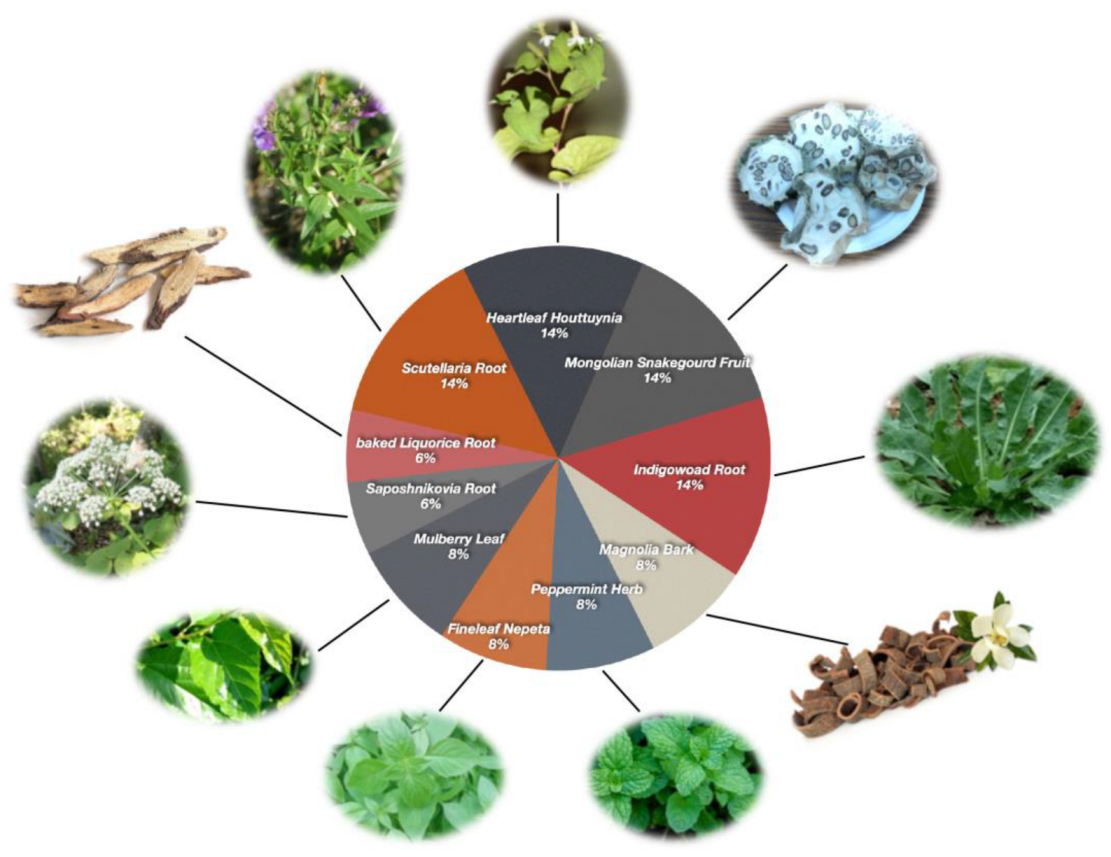
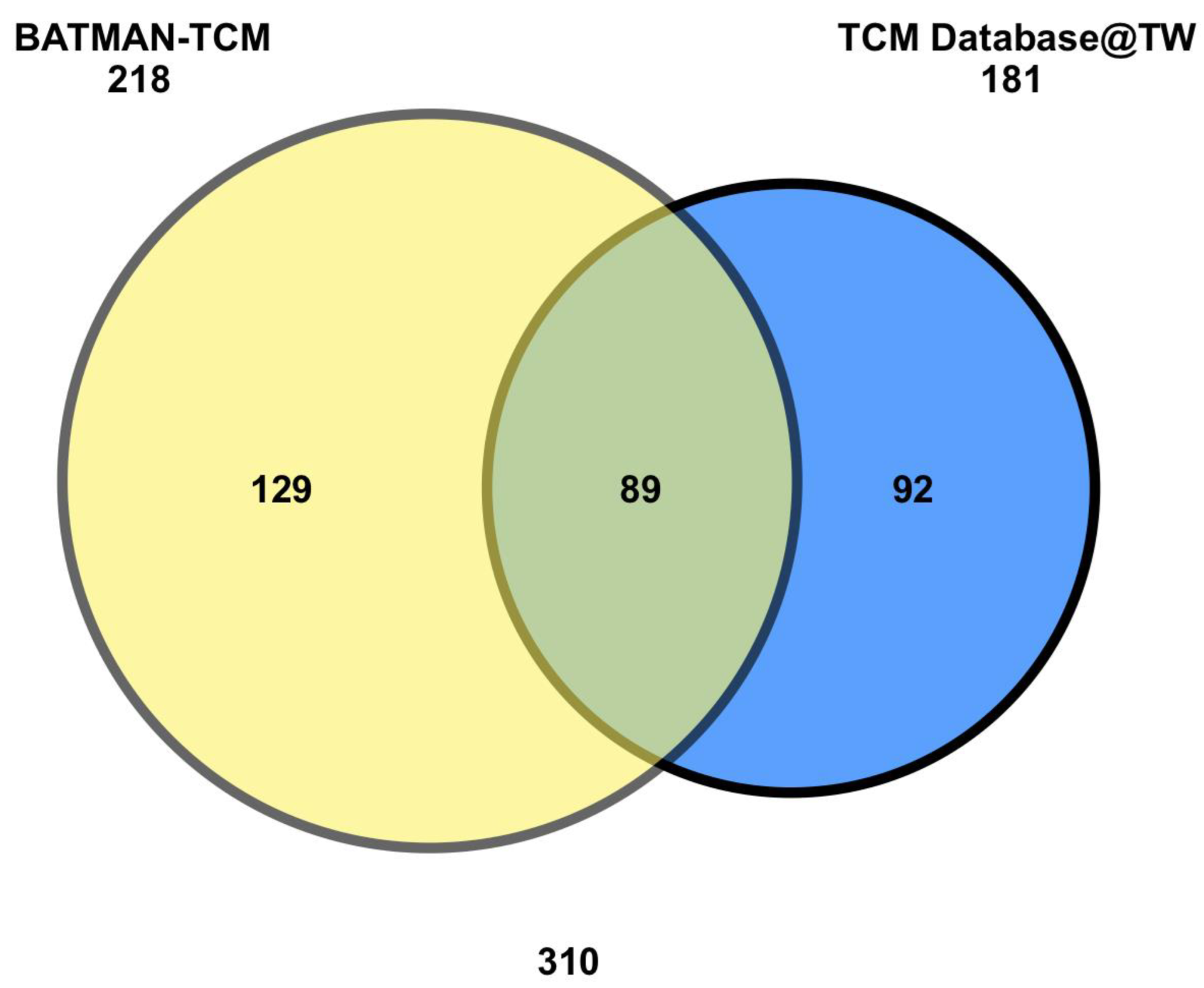
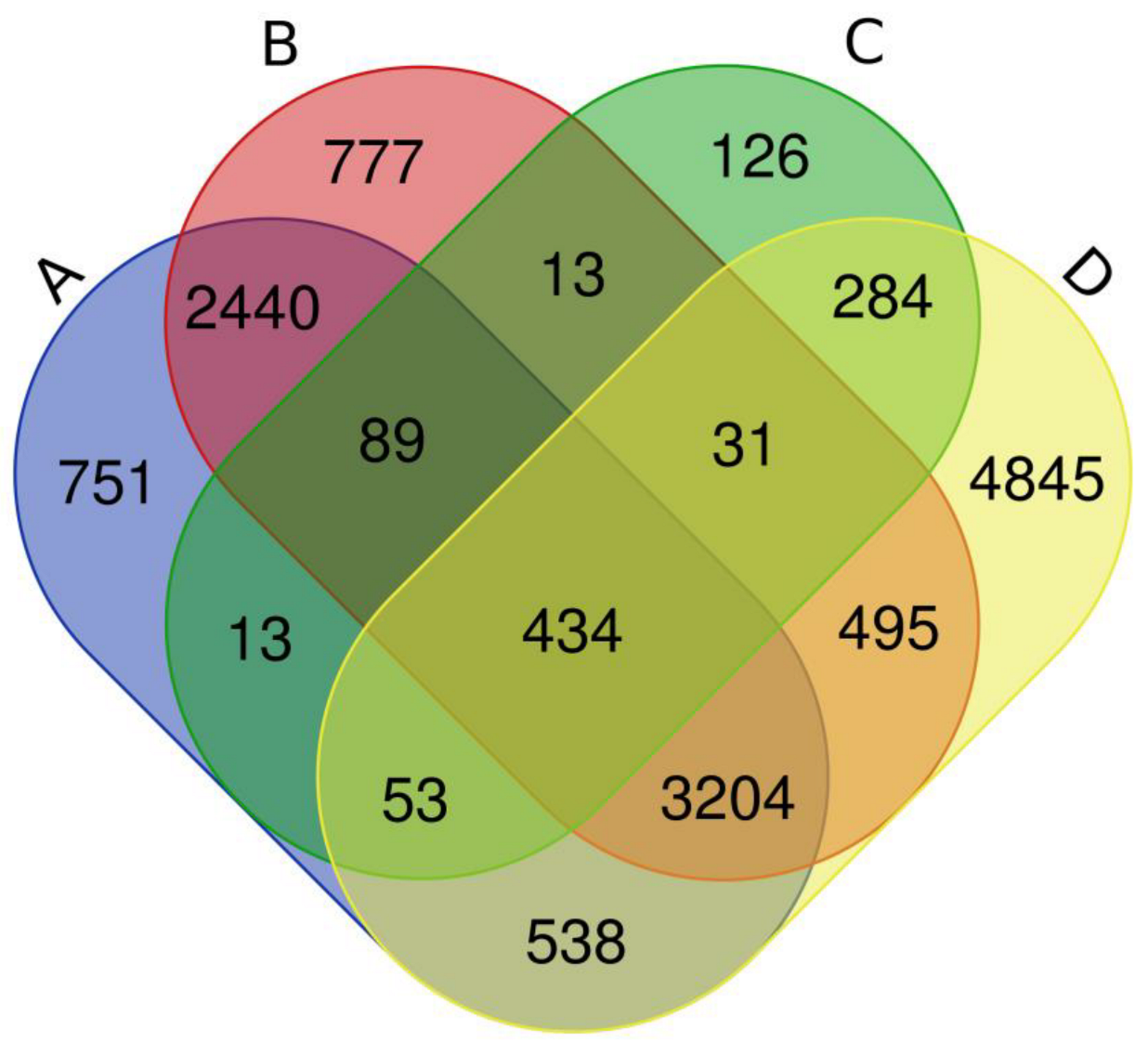

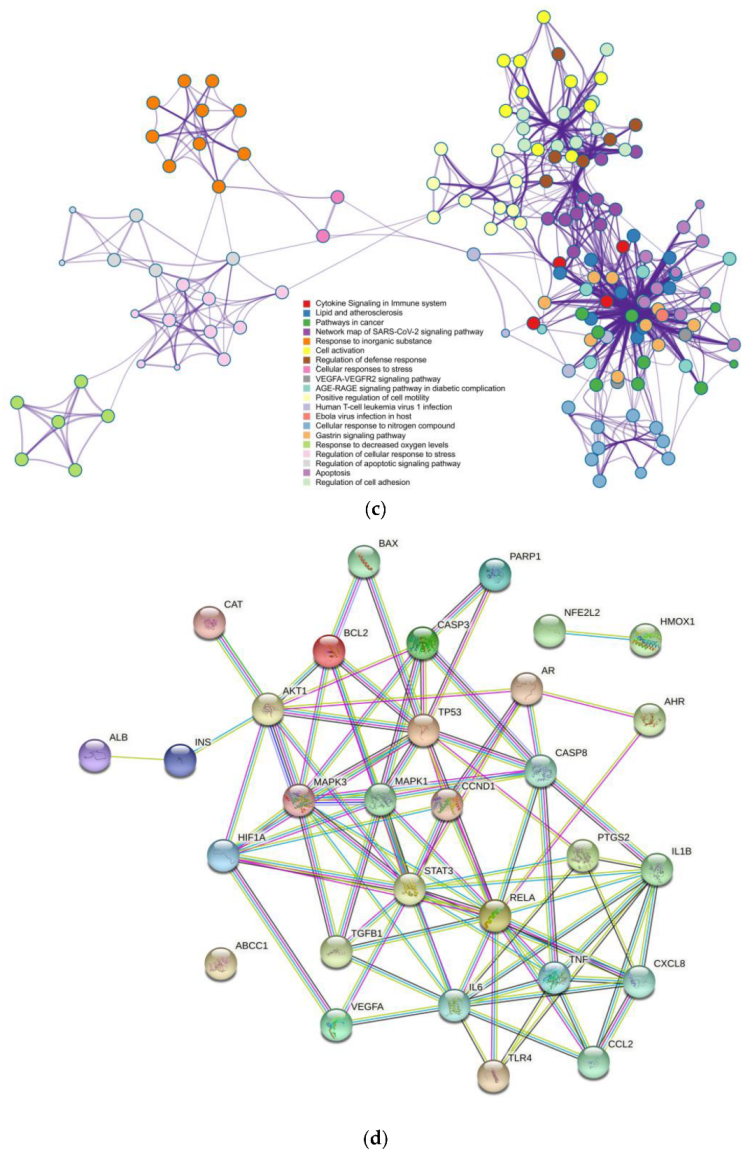
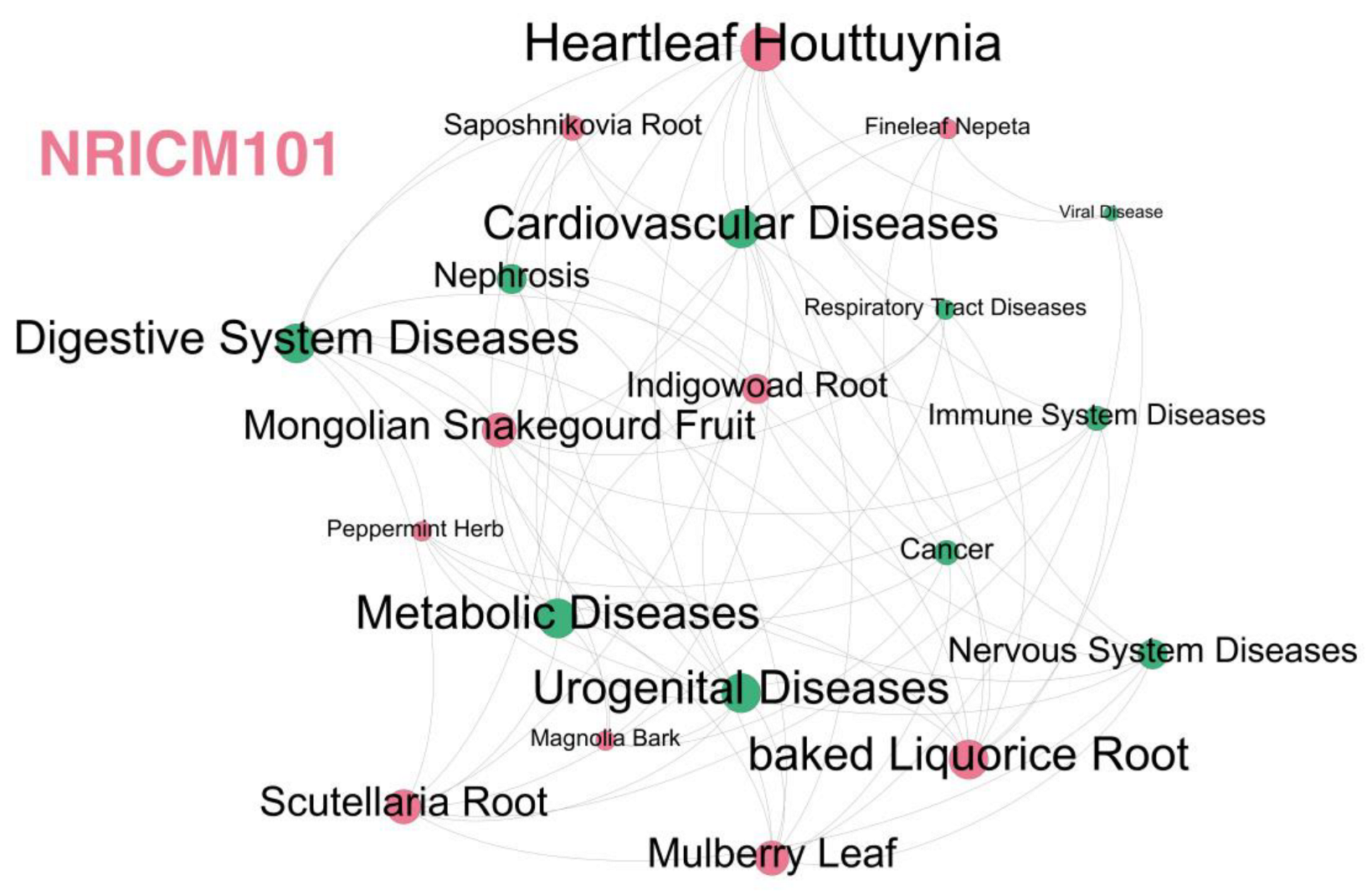
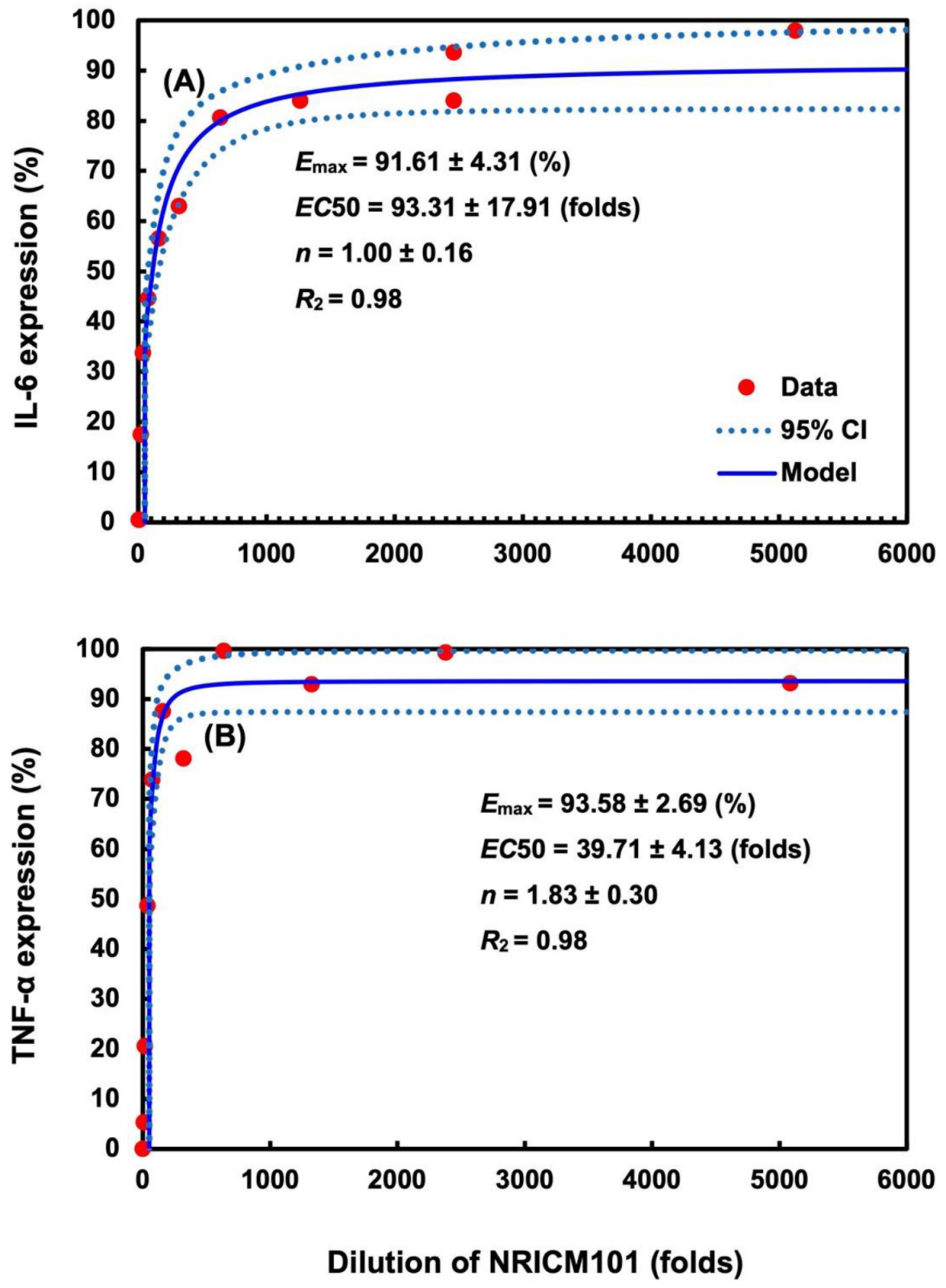
| Herbs | Binomial Name | Category | Weight (g) |
|---|---|---|---|
| Scutellaria Root | Scutellaria baicalensis | Heat-clearing and damp-drying medicine | 18.75 |
| Heartleaf Houttuynia | Houttuynia cordata | Heat-clearing and detoxifying drugs | 18.75 |
| Mongolian Snakegourd Fruit | Trichosanthes kirilowii | Heat-clearing phlegm medicine | 18.75 |
| Indigowoad Root | Isatis indigotica | Heat-clearing and detoxifying drugs | 18.75 |
| Magnolia Bark | Magnolia officinalis | Dampness medicine | 11.25 |
| Peppermint Herb | Mentha haplocalyx | Diffuse wind-heat medicine | 11.25 |
| Fineleaf Nepeta | Nepeta tenuifolia | Traditional Chinese Medicine | 11.25 |
| Mulberry Leaf | Morus alba | Traditional Chinese Medicine | 11.25 |
| Saposhnikovia Root | Saposhnikovia divaricata | Traditional Chinese Medicine | 7.50 |
| Baked Licorice Root | Glycyrrhiza glabra | Invigorating Qi Medicine | 7.50 |
| Gene Symbols | Count@CTD | Gene Names | Location |
|---|---|---|---|
| TNF | 298 | tumor necrosis factor | 6p21.33 |
| CASP3 | 178 | caspase 3 | 4q35.1 |
| IL1B | 157 | interleukin 1 beta | 2q14.1 |
| INS | 92 | insulin | 11p15.5 |
| AKT1 | 89 | AKT serine/threonine kinase 1 | 14q32.33 |
| BAX | 81 | BCL2 associated X, apoptosis regulator | 19q13.33 |
| BCL2 | 79 | BCL2 apoptosis regulator | 18q21.33 |
| NFE2L2 | 76 | NFE2 like bZIP transcription factor 2 | 2q31.2 |
| IL6 | 74 | interleukin 6 | 7p15.3 |
| CXCL8 | 71 | C-X-C motif chemokine ligand 8 | 4q13.3 |
| AHR | 70 | aryl hydrocarbon receptor | 7p21.1 |
| RELA | 69 | RELA proto-oncogene, NF-κB subunit | 11q13.1 |
| PTGS2 | 66 | prostaglandin-endoperoxide synthase 2 | 1q31.1 |
| MAPK3 | 61 | mitogen-activated protein kinase 3 | 16p11.2 |
| MAPK1 | 58 | mitogen-activated protein kinase 1 | 22q11.22 |
| TP53 | 58 | tumor protein p53 | 17p13.1 |
| PARP1 | 52 | poly(ADP-ribose) polymerase 1 | 1q42.12 |
| HMOX1 | 52 | heme oxygenase 1 | 22q12.3 |
| AR | 47 | androgen receptor | Xq12 |
| HIF1A | 45 | hypoxia inducible factor 1 subunit alpha | 14q23.2 |
| STAT3 | 43 | signal transducer and activator of transcription 3 | 17q21.2 |
| VEGFA | 37 | vascular endothelial growth factor A | 6p21.1 |
| TGFB1 | 36 | transforming growth factor beta 1 | 19q13.2 |
| CCL2 | 36 | C-C motif chemokine ligand 2 | 17q12 |
| CCND1 | 35 | cyclin D1 | 11q13.3 |
| CASP8 | 35 | caspase 8 | 2q33.1 |
| ALB | 32 | albumin | 4q13.3 |
| TLR4 | 31 | toll like receptor 4 | 9q33.1 |
| CAT | 29 | catalase | 11p13 |
| ABCC1 | 29 | ATP binding cassette subfamily C member 1 | 16p13.11 |
| Disease Name | Disease ID | Disease Categories | p-Value | Corrected p-Value | Annotated Genes Quantity | Genome Frequency |
|---|---|---|---|---|---|---|
| Vascular Diseases | MESH:D014652 | Cardiovascular disease | 9.56 × 10−48 | 1.05 × 10−44 | 29 | 966/44,746 genes: 2.16% |
| Cardiovascular Diseases | MESH:D002318 | Cardiovascular disease | 6.11 × 10−45 | 6.71 × 10−42 | 30 | 1517/44,746 genes: 3.39% |
| Neoplastic Processes | MESH:D009385 | Cancer|Pathology (process) | 2.66 × 10−44 | 2.92 × 10−41 | 25 | 516/44,746 genes: 1.15% |
| Gastrointestinal Diseases | MESH:D005767 | Digestive system disease | 1.24 × 10−43 | 1.36 × 10−40 | 28 | 1072/44,746 genes: 2.40% |
| Heart Diseases | MESH:D006331 | Cardiovascular disease | 3.07 × 10−43 | 3.37 × 10−40 | 28 | 1107/44,746 genes: 2.47% |
| Endocrine System Diseases | MESH:D004700 | Endocrine system disease | 1.70 × 10−42 | 1.86 × 10−39 | 28 | 1176/44,746 genes: 2.63% |
| Cerebrovascular Disorders | MESH:D002561 | Cardiovascular disease|Nervous system disease | 2.57 × 10−42 | 2.82 × 10−39 | 21 | 224/44,746 genes: 0.50% |
| Male Urogenital Diseases | MESH:D052801 | Urogenital disease (male) | 6.58 × 10−42 | 7.23 × 10−39 | 29 | 1528/44,746 genes: 3.41% |
| Diabetes Mellitus | MESH:D003920 | Endocrine system disease|Metabolic disease | 1.38 × 10−41 | 1.51 × 10−38 | 23 | 410/44,746 genes: 0.92% |
| Liver Diseases | MESH:D008107 | Digestive system disease | 2.08 × 10−41 | 2.29 × 10−38 | 30 | 1985/44,746 genes: 4.44% |
| Central Nervous System Diseases | MESH:D002493 | Nervous system disease | 5.49 × 10−41 | 6.03 × 10−38 | 28 | 1330/44,746 genes: 2.97% |
| Respiratory Tract Diseases | MESH:D012140 | Respiratory tract disease | 9.99 × 10−41 | 1.10 × 10−37 | 27 | 1101/44,746 genes: 2.46% |
| Lung Diseases | MESH:D008171 | Respiratory tract disease | 1.96 × 10−40 | 2.15 × 10−37 | 26 | 912/44,746 genes: 2.04% |
| Brain Diseases | MESH:D001927 | Nervous system disease | 7.75 × 10−40 | 8.51 × 10−37 | 27 | 1187/44,746 genes: 2.65% |
| Reperfusion Injury | MESH:D015427 | Cardiovascular disease|Pathology (process) | 1.71 × 10−39 | 1.88 × 10−36 | 19 | 169/44,746 genes: 0.38% |
| Gastrointestinal Neoplasms | MESH:D005770 | Cancer|Digestive system disease | 4.00 × 10−39 | 4.39 × 10−36 | 25 | 825/44,746 genes: 1.84% |
| Hypertension | MESH:D006973 | Cardiovascular disease | 7.60 × 10−39 | 8.35 × 10−36 | 20 | 245/44,746 genes: 0.55% |
| Postoperative Complications | MESH:D011183 | Pathology (process) | 8.40 × 10−39 | 9.23 × 10−36 | 19 | 183/44,746 genes: 0.41% |
| Pathologic Processes | MESH:D010335 | Pathology (process) | 2.37 × 10−38 | 2.61 × 10−35 | 30 | 2506/44,746 genes: 5.60% |
| Genital Diseases | MESH:D000091662 | 3.40 × 10−38 | 3.73 × 10−35 | 27 | 1364/44,746 genes: 3.05% | |
| Female Urogenital Diseases | MESH:D052776 | Urogenital disease (female) | 6.01 × 10−38 | 6.60 × 10−35 | 27 | 1393/44,746 genes: 3.11% |
| Urogenital Diseases | MESH:D000091642 | 1.16 × 10−37 | 1.27 × 10−34 | 29 | 2136/44,746 genes: 4.77% | |
| Nervous System Diseases | MESH:D009422 | Nervous system disease | 2.15 × 10−37 | 2.36 × 10−34 | 30 | 2696/44,746 genes: 6.03% |
| Digestive System Neoplasms | MESH:D004067 | Cancer|Digestive system disease | 2.28 × 10−37 | 2.50 × 10−34 | 27 | 1463/44,746 genes: 3.27% |
| Wounds and Injuries | MESH:D014947 | Wounds and injuries | 2.48 × 10−37 | 2.73 × 10−34 | 19 | 217/44,746 genes: 0.48% |
| Cardiomyopathies | MESH:D009202 | Cardiovascular disease | 2.87 × 10−37 | 3.15 × 10−34 | 20 | 292/44,746 genes: 0.65% |
| Lung Neoplasms | MESH:D008175 | Cancer|Respiratory tract disease | 5.63 × 10−37 | 6.18 × 10−34 | 23 | 645/44,746 genes: 1.44% |
| Respiratory Tract Neoplasms | MESH:D012142 | Cancer|Respiratory tract disease | 6.74 × 10−37 | 7.40 × 10−34 | 23 | 650/44,746 genes: 1.45% |
| Thoracic Neoplasms | MESH:D013899 | Cancer | 6.99 × 10−37 | 7.67 × 10−34 | 23 | 651/44,746 genes: 1.45% |
| Digestive System Diseases | MESH:D004066 | Digestive system disease | 8.26 × 10−37 | 9.07 × 10−34 | 30 | 2819/44,746 genes: 6.30% |
| hsa-miR-31-5p | ||||||||
|---|---|---|---|---|---|---|---|---|
| Gene | miRabel Score | PITA | miRanda | SVMicrO | TargetScan | ExpVal | 5′UTR | CDS |
| CXCL8 | 0.992007 | 3689 | - | - | - | NO | NO | YES |
| TGFB1 | 0.973495 | 4950 | 5760 | - | - | NO | NO | NO |
| STAT3 | 0.967355 | 5261 | 5014 | - | - | NO | NO | YES |
| VEGFA | 0.853542 | 3537 | 1675 | - | - | NO | NO | NO |
| ALB | 0.817103 | 1213 | 2922 | - | - | NO | NO | YES |
| AHR | 0.699523 | 6587 | 3055 | - | 2730 | NO | NO | NO |
| MAPK1 | 0.37997 | 3026 | 2550 | - | 2199 | NO | NO | NO |
| PARP1 | 0.211814 | 3328 | 424 | - | 1367 | YES | NO | YES |
| TLR4 | 0.117578 | 151 | 727 | - | 2149 | NO | NO | YES |
| AR | 0.0587212 | 431 | 348 | - | 162 | NO | NO | YES |
| hsa-miR-1275 | ||||||||
| PARP1 | 0.996829 | 6499 | - | 10,247 | - | NO | NO | YES |
| HMOX1 | 0.995508 | 5737 | - | 9682 | - | NO | NO | YES |
| CASP8 | 0.99529 | - | 6015 | 7537 | - | NO | NO | YES |
| AKT1 | 0.980752 | 7480 | 6376 | 5807 | - | NO | NO | NO |
| CCL2 | 0.965806 | 588 | - | 7875 | - | NO | NO | YES |
| MAPK3 | 0.948772 | 7059 | 3780 | 5233 | - | NO | NO | YES |
| AHR | 0.934906 | 6196 | 3884 | 6468 | - | NO | NO | YES |
| MAPK1 | 0.916016 | 4397 | - | 6283 | 4585 | NO | YES | NO |
| ABCC1 | 0.909767 | 2023 | 6924 | 5072 | - | NO | NO | NO |
| RELA | 0.788465 | - | 3043 | 14,573 | 2276 | NO | NO | YES |
| VEGFA | 0.712891 | 6277 | 6815 | 2039 | - | NO | NO | NO |
| TP53 | 0.108736 | 13 | 305 | 2937 | - | NO | NO | YES |
| STAT3 | 0.0711241 | 6311 | 1637 | 2321 | 2840 | NO | NO | YES |
| TGFB1 | 0.0589265 | 4304 | 2364 | 1363 | 4383 | NO | YES | NO |
Publisher’s Note: MDPI stays neutral with regard to jurisdictional claims in published maps and institutional affiliations. |
© 2022 by the authors. Licensee MDPI, Basel, Switzerland. This article is an open access article distributed under the terms and conditions of the Creative Commons Attribution (CC BY) license (https://creativecommons.org/licenses/by/4.0/).
Share and Cite
Singh, S.; Yang, Y.-F. Pharmacological Mechanism of NRICM101 for COVID-19 Treatments by Combined Network Pharmacology and Pharmacodynamics. Int. J. Mol. Sci. 2022, 23, 15385. https://doi.org/10.3390/ijms232315385
Singh S, Yang Y-F. Pharmacological Mechanism of NRICM101 for COVID-19 Treatments by Combined Network Pharmacology and Pharmacodynamics. International Journal of Molecular Sciences. 2022; 23(23):15385. https://doi.org/10.3390/ijms232315385
Chicago/Turabian StyleSingh, Sher, and Ying-Fei Yang. 2022. "Pharmacological Mechanism of NRICM101 for COVID-19 Treatments by Combined Network Pharmacology and Pharmacodynamics" International Journal of Molecular Sciences 23, no. 23: 15385. https://doi.org/10.3390/ijms232315385
APA StyleSingh, S., & Yang, Y.-F. (2022). Pharmacological Mechanism of NRICM101 for COVID-19 Treatments by Combined Network Pharmacology and Pharmacodynamics. International Journal of Molecular Sciences, 23(23), 15385. https://doi.org/10.3390/ijms232315385






